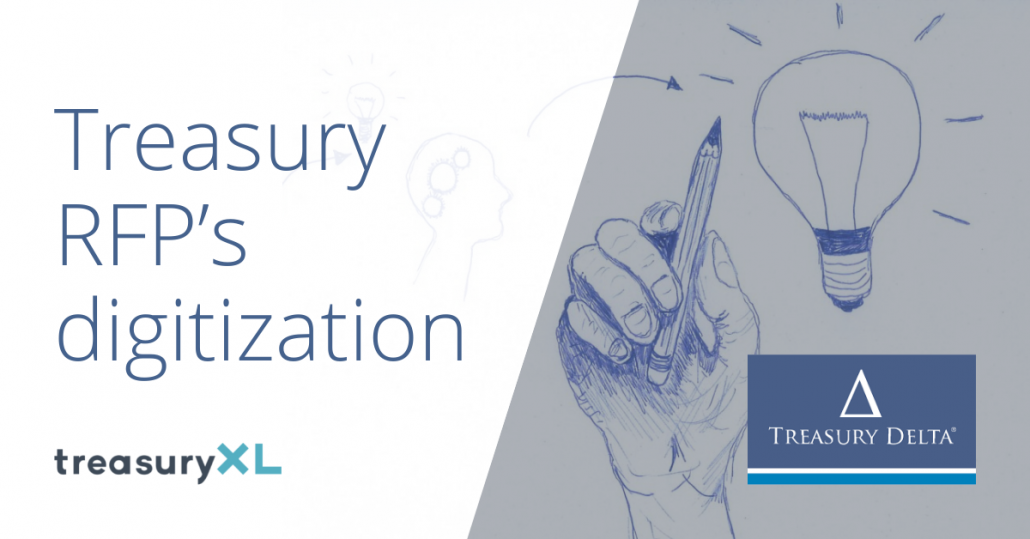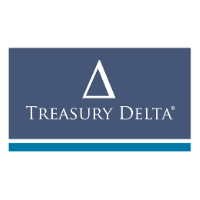06-04-2022 | treasuryXL | Treasury Delta | LinkedIn |
The optimal, objective, and transparent selection of treasury supplier solutions and/or banking services, observing procurement principles and guidelines, remains a complicated challenge for all treasurers. It is extremely time-consuming and cost-ineffective. This article highlights a niche fintech solution developed by Treasury Delta to successfully digitize the tender processes and streamline an RFP project for all stakeholders.
Credits: François Masquelier
Source

RFP’s, typical documents treasurers don’t like to produce
When choosing a tool or service of a certain price, for obvious reasons of independence, security, and protection of the company’s interests, one goes through a proper tender. Most of the time, Request for Proposal’s (i.e., RFP) are mandatory (above a minimum threshold) to guarantee the proper execution and the best interest of the shareholders, when choosing a solution. It is also a competitive tool, which forces competitors to outdo each other to offer their best solution, pricing, and service offering. However, this process can be long (i.e., the preparation of a complete document that must be exhaustive), tedious to compile (a lot of diverse information, sometimes amalgamated anarchically), far from being fun to produce, often considered long and boring because it is too manual. It is possible to standardize the format when you are organized, but often companies or the Procurement department do not impose a particular form or a standard model, and even less a predefined tech solution. It is up to each one to make his/her own analysis, as far as it can be advanced during an audit (if any). They can be found in the form of EXCEL, WORD, POWERPOINT or other files, and sometimes even combined, which makes reading complex, prone to error and very tedious.
RFP, a controlling process to guarantee the company’s best interest
The RFP has a control dimension (i.e., ensuring that the selection is carried out correctly and in the best interest of the company) and an analysis dimension (i.e., ensuring the comparability of the offers to retain only the best one, according to previously defined and weighted criteria, case-by-case basis). Today what treasurers do without an adapted tool, is they compile the answers on an XL file (most often) that they consolidate for comparability and try to weight and calculate the best and/or most competitive offer. They often must re-enter the data or copy-paste them, in tedious and time-consuming operations. It is a control exercise (does the tool or solution meet all the required functionalities or services?) and a pricing exercise based on volume assumptions to compare “comparable offers”. However, in the end, the choice is most often made on the least expensive of the most complete solutions proposed.
Complicated exercise that no one likes
But whatever your organization and the formatted spreadsheet, it remains a difficult exercise, because it is personal, and without reference or standard model. Each time, we start from a blank sheet, or almost, because we don’t do it every day and the last one, we did was many years ago. How many times have I heard treasurers ask me for an example of a Request for Proposal? As if they didn’t have one. They often call on consultants to do it, and so much the better for them. In the age of digitalization, it seems to me that it would be useful to structure your RFP in a more digital way. There are tools to make the treasurer’s life easier during this selection and to ensure completeness with a predefined framework, for different calls for tender. If we talk about RFP in treasury, we imagine it for the choice of a TMS, the selection of a cash management or cash-pooling structure, but also for a “Payment Factory” / “Bank Single Gateway” or “In-House Bank”, a review of the banking conditions or the choice of a “core bank”, one or more additional IT tools used for treasury management or even a GRC. Fortunately, you may think, we don’t do this every day. But because of this, we often have no or few reference models and when we do, they are obsolete because they are (too) old and corporate user needs have changed given technological advancements. The idea here is to structure on a secure, formatted platform, with blocking controls, a framework for launching an RFP to be comprehensive, organized (to make it easier for us and them to do their job – “sell and buy sides”) and to facilitate comparability. If you already start with the right framework with an organized and standardized structure, the work will only be easier (for all parties including consultants). The advantage of such a tool is that it is dynamic, and pre-formatted while remaining modular and customizable. Finally, demonstrating good organization with such a fintech tool allows participants to show their professionalism and leverage digital technology. Moreover, internally, it allows to easily verify through audits (thanks to audit trails) the work done and by whom, as well as the relevance of the choice and the respect of governance measures to fight against corruption or partisan choices.
Proprietary platform to design own RPF’s in a structured way
Fortunately, once again technology is coming to the aid of financiers and more specifically of treasurers. There are now, with solutions like Treasury Delta, ways to make your RFP process more robust, transparent, fast and cost-effective, while using a tool that is far more dynamic than the dangerous XL sheets, the treasurer’s panacea. My advice is to use these proprietary, individualized platforms so that it allows you to define precisely what the company need is, in a very structured and transparent way. This is very virtuous because such a tool will save time and money for all parties, while involving all stakeholders and respecting, in passing, all the internal rules of governance in procurement (if they exist). With such a tool you professionalize the RFP approach, you impress the potential suppliers, and you also make their job easier and hassle-free, which they will appreciate. So, it seems to me that continuing to use vulgar spreadsheets is incensed from an Enterprise Risk Management and Internal Governance point of view, at a time when the fight against fraud and internal corruption is maximal. To do without it would be madness.



